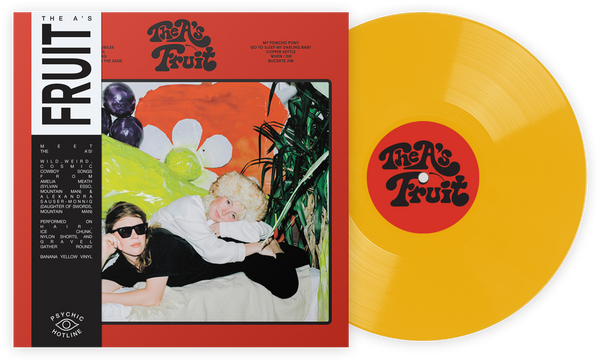These days, most albums are impossible to separate from the story of their creation. In a lot of ways, the creation is as much of a story as the album itself. Think of the band Tennis recording their album on a sailing trip, or Gucci Mane recording Everbody’s Looking while on house arrest. But the opposite can be true too: Sometimes, the music itself has a story, and an album isn’t just a collection of songs: the album has an overarching story you can trace throughout the album.
So, here’s a celebration of those albums that have that bigger story. We present the 10 best concept albums to own on vinyl.

Pink Floyd: The Wall
While almost all musicians are inspired by people they turn into characters, some musicians are inspired by themselves. The most notable example is the most notable character of one of the most notable concept albums ever made. Pink, the protagonist of 1979’s The Wall, is modeled on a mixture of Pink Floyd band member Roger Waters and former member Syd Barrett, who had already left the band when the album was released. On the album, the troubled Pink battles with his place in society, eventually going into self-imposed exile (not On Main Street) as the metaphorical wall of his isolation grows stronger by the song. The album includes several references to Waters and Barrett. “Nobody Home,” for instance, reflects on the condition of the latter during one of Pink Floyd’s abortive U.S. tours, while hit “Comfortably Numb” was based on another tour, when Waters injected himself with muscle relaxant.

The Who: Tommy
Pink Floyd’s The Wall is undoubtedly one of the finest rock operas ever, but it might just lose out narrowly to The Who’s Tommy, which was released 10 years earlier. Together with the Pretty Things’ S.F. Sorrow, Tommy is seen as one of the first rock operas, though members of the Who have dismissed rumours that S.F. Sorrow formed the inspiration for the story of Tommy, a deaf, dumb and blind kid who plays pinball (hence “Pinball Wizard”) and starts a religious movement. That story seems so unbelievable at first that it’s a huge achievement that the rollercoaster recorded succeeds in engaging the listener in the way that it does. In fact, the protagonist of the Who’s fourth full-length may not be Tommy after all: it’s the story itself. The plot was so good, actually, that Tommy was made into a feature film and a musical decades after the release of the concept album. The success of Tommy was a relief for frontman Pete Townshend, who was involved in the production of both the film and musical.

David Bowie: The Rise And Fall Of Ziggy Stardust And The Spiders From Mars
Many concept albums tell tales of life on earth. However, there is only one (as far as we know) that does so through the eyes of an alien. In 1972, David Bowie, assisted by his band the Spiders From Mars, assumed the role of flame-haired, bisexual Martian Ziggy Stardust, one of his many alter egos supposedly based on fellow rock stars Jimi Hendrix and Vince Taylor, whom Bowie met after Taylor had a mental breakdown and proclaimed to be a combination between God and an alien. On some of Bowie’s finest tracks, such as “Moonage Daydream” and “Starman,” Stardust shares his views on earthly sensations such as sex, love and rock-'n'-roll. When touring, Bowie/Stardust, then at the nadir of drug addiction, announced that he would quit forever, leaving fans confused as they were unable to figure out if this meant Bowie’s or Stardust’s goodbye. They were relieved when the former returned with another fine record, Aladdin Sane, just one year later.

The Beatles: Sgt. Pepper’s Lonely Hearts Club Band
Solo artists are not the only ones who have experimented with alter egos throughout pop history. In 1967, Sgt. Pepper’s Lonely Hearts Club Band provided the Beatles with a license to pursue the sonic experimentation which they had started on 1966’s Revolver. As Sgt. Pepper’s is seen as the first concept album in popular music, the record is one of the many available examples of the Fab Four’s ground-breaking qualities. The band had already started recording the new Beatles album when Paul McCartney suggested the Brits would create an entire album in the style of the fictional military band, after having written the song that would provide the album’s title. The Beatles’ use of sounds and textures that weren’t usually associated with pop music up to that point was heavily inspired by The Beach Boys’ Pet Sounds. McCartney later admitted he thought his constant playing of the record made it hard for his bandmates to escape the influence of it, while producer George Martin has stated that Sgt. Pepper’s wouldn’t have existed without Pet Sounds.

Arcade Fire: The Suburbs
Reflektor isn’t the only Arcade Fire record that is, at least partially, a concept album. The Canadian band’s third record was described by frontman Win Butler as “neither a love letter to, nor an indictment of, the suburbs–it’s a letter from the suburbs.” Through artful pop tunes like “Ready To Start,” “The Suburbs” and “Empty Room,” Arcade Fire succeeded in making the minuscular everyday lives of everyday people seem like the most massive subjects in the whole wide world. The record is directly inspired by the personal history of Win and his brother and band member Will Butler. The duo was brought up in the Woodlands, one of the suburbs of Houston, Texas. Accordingly, the music on the record is loosely based on the songs by Depeche Mode and Neil Young that Win Butler heard when he was young.

Green Day: American Idiot
Did anyone say suburbs? Now we’re here, we’re going to stay a little while longer. After all, there’s no place where the American Dream can be analysed quite as thoroughly. That dream, in all its largeness and littleness, was explored by Green Day on their 2004 concept album American Idiot through the eyes of characters like Jesus of Suburbia, Whatsername and St. Jimmy. The album showcased a maturity that hadn’t been found on any of Green Day first five albums, on which the band created some timeless punk rock anthems nevertheless.

Queens of the Stone Age: Songs For The Deaf
From Green Day’s birthplace East Bay, it’s not too long a drive to the Deserts of California, an area that, in recent decades, has been dominated by Queens of the Stone Age. Musical millipede Josh Homme has prevailed as a member of Kuyss, Them Crooked Vultures and Eagles of Death Metal and has worked with bands like Arctic Monkeys, Foo Fighters, Mastodon, Biffy Clyro and Nine Inch Nails, yet he has experienced his finest moments as frontman of Queens of the Stone Age. Arguably the finest of them all is represented by the band’s 2002 album Songs For The Deaf, which features hits like “No One Knows” and “Go With The Flow” as well as Dave Grohl on drums. The songs on Songs For The Deaf aren’t all thematically related, but Queens of the Stone Age take the listener on a drive through the California desert. The tracks are linked together by snatches of radio stations that are being picked up along the way.

Kendrick Lamar: good kid, m.A.A.d. city
Kendrick Lamar’s second studio album is an autobiographical account of his youth and young manhood on the streets of Compton, California. The cover artwork features Lamar, his grandfather and two of his uncles. The eyes of the men are censored, because the story is told from young Kendrick’s point of view. good kid, m.A.A.d. city exists in a nonlinear narrative of a night spent out robbing houses with friends, but for his latest full-length, the critically acclaimed To Pimp A Butterfly, Lamar changed to a more linear form of storytelling.

Sufjan Stevens: Illinois
Kendrick Lamar’s* good kid, m.A.A.d. city* and Sufjan Stevens’ Illinois don’t share much on first sight, but the two albums possess quite similar concepts. While it seems Stevens’ initial mission to record an album for each of the U.S.’ 50 states will not be accomplished anytime soon, the second LP in the series (after 2003’s Michigan) delivers a detailed account of all facets of Illinois. The 22 tracks on the album, most of them with incredibly lengthy titles, range from descriptions of cultural events to personal reflections on city life and Christianity. Stevens strings together a wide range of facts and anecdotes about the states through songs on characters like Abraham Lincoln, Superman and serial killer John Wayne Gacy Jr. in the confessional yet confusing manner that Stevens has mastered like no other. His tales about one state succeeded in convincing us all that we are not that different from one another.

Frank Sinatra: Watertown
From a city to a state, and from a state to a town. From some of the most notable concept albums of the 21st century to the moment when it all begun. Or rather, to the man who started it all. In addition to the string of storytelling records he released in the 1940s, the legendary Frank Sinatra is oftentimes seen as the founding father of the concept album. Perhaps the finest of all Sinatra’s concept albums though, is 1970’s Watertown, with music by the Four Seasons’ Bob Gaudio. On Watertown, situated in the village of the same name in New York, a nameless narrator tells the listener how his wife has left him and their two boys for the lure of the big city in a series of heart-breaking monologues. The saddest thing about Watertown, however, is that the album sold merely 30,000 copies and is thereby the only one of Sinatra’s major album releases not to reach the Billboard Top 100.
Join the Club!
Join Now, Starting at $44
Exclusive 15% Off for Teachers, Students, Military members, Healthcare professionals & First Responders - Get Verified!












